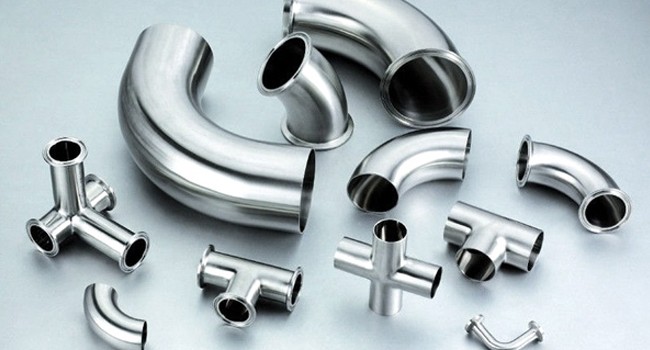Stainless Steel Pipe Fittings
Stainless steel pipe fittings belong to pipe fittings, and they are made of stainless steel materials. Stainless steel pipe fittings include stainless steel elbows, stainless steel tees, stainless steel crosses, stainless steel reducers, stainless steel caps, etc., and they can be divided into socket stainless steel pipe fittings, threaded stainless steel pipe fittings, flanged stainless steel pipe fittings and welded stainless steel pipe fittings four categories according to connection modes. Stainless steel elbows are applied to where the pipes need to make turns; flanges are parts which are used to connect pipe ends of two pipes; stainless steel tees are used at the meeting points of three pipes; stainless steel crosses are used for the meeting points of four pipes; stainless steel reducers are used for connecting two pipes with different diameters. The main stainless steel materials are 304, 304L, 316 and 316L.
Stainless steel pipe fittings are generic terms for all kinds of stainless steel parts which are used to connect pipelines, and they can be classified into different categories based on shapes, applications, connection modes, etc. Stainless steel pipe fittings have features of easy installation, good performance and being durable, which are widely used for various pipeline construction and installation.
What kind of matter we need to pay attention to when we install stainless steel pipe fittings?
1. When the stainless steel materials are hoisted, they can not have direct contact with other metals. Therefore, we need to put wood boards or rubber sheets under the stainless steel materials.
2. Using ordinary grinding wheels to cut pipe fittings is not allowed; we should adopt special grinding wheels or plasma cutting for stainless steel.
3. When we have positioned weld processes for stainless steel pipes and pipe fittings, we need to protect the inner welding seams by filling them with argon.
4. We should pay attention to arc starting and arc stopping. We should adopt reflow soldering for arc starting and fill arc craters for the arc stopping process; the arc starting process should be completed in the groove; arc striking and arc starting on base metals of pipes and pipe fittings are forbidden. If blowholes and cracks are found at the parts where we had arc starting and arc stopping processes, we will need to remove them in time.
5. When we connect stainless steel pipes to stainless steel pipe fittings, stainless steel pipes or stainless steel pipe fittings to non stainless steel pipes or non stainless steel pipe fittings, the pipes' and the pipe fittings' cavities should be filled with argon before the joint parts having back weld processes so that the TIG welds can be adopted.
6. The parts which have the arc starting and arc stopping of multi layer welding should be staggered.
7. When we continue to weld stainless steel materials, temperature of the interlayer should not exceed 60℃.
8. There should be pickling and passivation treatment for seams at pipelines' welding parts after welding pipelines.
9. Hydraulic tests of stainless steel pipe fittings have certain requirements of water temperatures and water quality; the water temperature should not be lower than 5℃ and chloride ion content in the water should not be greater than 25ppm.
Stainless steel pipe fittings are generic terms for all kinds of stainless steel parts which are used to connect pipelines, and they can be classified into different categories based on shapes, applications, connection modes, etc. Stainless steel pipe fittings have features of easy installation, good performance and being durable, which are widely used for various pipeline construction and installation.
What kind of matter we need to pay attention to when we install stainless steel pipe fittings?
1. When the stainless steel materials are hoisted, they can not have direct contact with other metals. Therefore, we need to put wood boards or rubber sheets under the stainless steel materials.
2. Using ordinary grinding wheels to cut pipe fittings is not allowed; we should adopt special grinding wheels or plasma cutting for stainless steel.
3. When we have positioned weld processes for stainless steel pipes and pipe fittings, we need to protect the inner welding seams by filling them with argon.
4. We should pay attention to arc starting and arc stopping. We should adopt reflow soldering for arc starting and fill arc craters for the arc stopping process; the arc starting process should be completed in the groove; arc striking and arc starting on base metals of pipes and pipe fittings are forbidden. If blowholes and cracks are found at the parts where we had arc starting and arc stopping processes, we will need to remove them in time.
5. When we connect stainless steel pipes to stainless steel pipe fittings, stainless steel pipes or stainless steel pipe fittings to non stainless steel pipes or non stainless steel pipe fittings, the pipes' and the pipe fittings' cavities should be filled with argon before the joint parts having back weld processes so that the TIG welds can be adopted.
6. The parts which have the arc starting and arc stopping of multi layer welding should be staggered.
7. When we continue to weld stainless steel materials, temperature of the interlayer should not exceed 60℃.
8. There should be pickling and passivation treatment for seams at pipelines' welding parts after welding pipelines.
9. Hydraulic tests of stainless steel pipe fittings have certain requirements of water temperatures and water quality; the water temperature should not be lower than 5℃ and chloride ion content in the water should not be greater than 25ppm.

Next: Specifications of Steel Pipe Fittings
Previous: Knowledge Related to Pipe Caps

